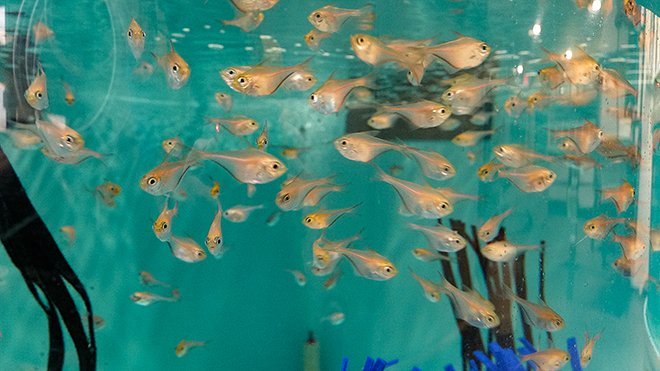Glassy Sweepers Successfully Raised for First Time by RWU and New England Aquarium Scientists
Collaborative sustainable-fish-breeding initiative brings iridescent marine fish species to display at Aquarium

BOSTON – Nocturnal glassy sweepers swim in schools off the coast of Florida and the Caribbean, like little streaks of light in a black sky. Now these silvery tropical fish, with their round bellies and bug eyes, are on public display at the New England Aquarium in Boston, thanks to a breakthrough in sustainable fish breeding by aquarists from Roger Williams University and the Aquarium.
Through a long-time partnership in sustainable breeding of marine fish species, RWU and the Aquarium has successfully reared and raised the sought-for-display marine fish. About 75 juvenile glassy sweepers are on view in the Aquarium’s larval fishes exhibit in the Blue Planet Action Center.
“Sweepers are a species that we had always wanted to work with. They are so fragile in the wild that they are an ideal species for aquaculture,” said Andy Rhyne, a professor of marine biology at Roger Williams and Aquarium research scientist. “We are the first to raise any fish in this family. The work is the good example of a long-term strategic plan between RWU and the Aquarium, a hallmark of the program we have planned for years.”
The joint initiative officially began in 2008 when the two organizations joined forces to propagate fish in RWU’s Wet Lab, drawing on the university’s faculty expertise and hands-on student learning in the marine biology and aquaculture & aquarium science programs. The program aims to raise marine animal species from eggs to fish to encourage conservation and avoid removing wild fishes from their habitats.
Glassy sweepers are a fish species that are fragile in the wild, according to Rhyne. After spawning at the Aquarium’s Animal Care Center, the eggs are collected and transported to RWU, where they are raised from eggs to juvenile fish. This breeding success adds an important species to a growing program, which also includes striped burrfish, planehead filefish, brown chromis, sharknose gobies, and dwarf seahorses.
“The work we are doing to preserve and propagate vulnerable species is really important for zoos and aquariums,” Rhyne said. “It’s also vital for research and learning opportunities for our students, so we are enthusiastic about expanding this work with other institutions and within our walls.”
In the next two years, RWU and the Aquarium will continue to raise popular public aquarium species such as lookdowns, smallmouth grunts, and glassy sweepers as part of a larger initiative. Fish reared join the Aquarium’s collection of 15,000 animals as well as exhibits at other aquariums nationwide.